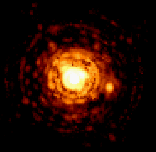Wolf 359
This extremely faint red dwarf star is the third closest to Sol after Alpha Centauri 3 and Barnard's Star. It is located only about 2.4 pc (7.8 light-years) away in the east central part (10:56:29+07:00.7, ICRS 2000.0) of Constellation Leo, the Lion -- south of Chertan or Coxa (Theta Leonis). However, the star is much too dim to be visible to the naked eye. It was discovered photographically by Max (Maximilian Franz Joseph Cornelius) Wolf (1863-1932), a pioneer of astrophotography who discovered hundreds of variable stars and asteroids, and about 5,000 nebulae by analyzing photographic plates and developing the "dry plate" in 1880 and the "blink comparator" in 1900 with the Carl Zeiss optics company in Jena, Germany. (Solstation)
 | Wolf 359 is comparable to the fainter companion star Gliese 623b at the right of the NASA image at left. Both it and the brighter Gliese 623a are red dwarfs. Wolf 359's position in the constellation Leo is near the ecliptic. It is characterized as a "flare star". Its closest neighbor is Ross 128, 1.16 pc or 3.79 ly away. |
"A very cool, main sequence red dwarf (M5.8Ve), Wolf 359 is our Sun's dimmest stellar neighbor within 10 ly, with less than 2/100,000th of Sol's luminosity. If our Sun, Sol, were replaced by Wolf 359, then an observer on Earth would need a telescope to see its round shape clearly, and daylight would be very dim with only ten times the brightness of full moonlight with Sol. On the other hand, Wolf 359 is a Flare Star (that has been designated with the variable star name CN Leonis) and so can brighten dramatically from time to time. Flares on Wolf 359, however, are rarer and not as violent as those observed on Proxima Centauri, Kruger 60 B, or UV Ceti."(solstation)
Sources:- http://www.solstation.com/stars/wolf359.htm
- http://en.wikipedia.org/wiki/Wolf_359
Nearby Stars
Star Concepts
| HyperPhysics***** Astrophysics | R Nave |